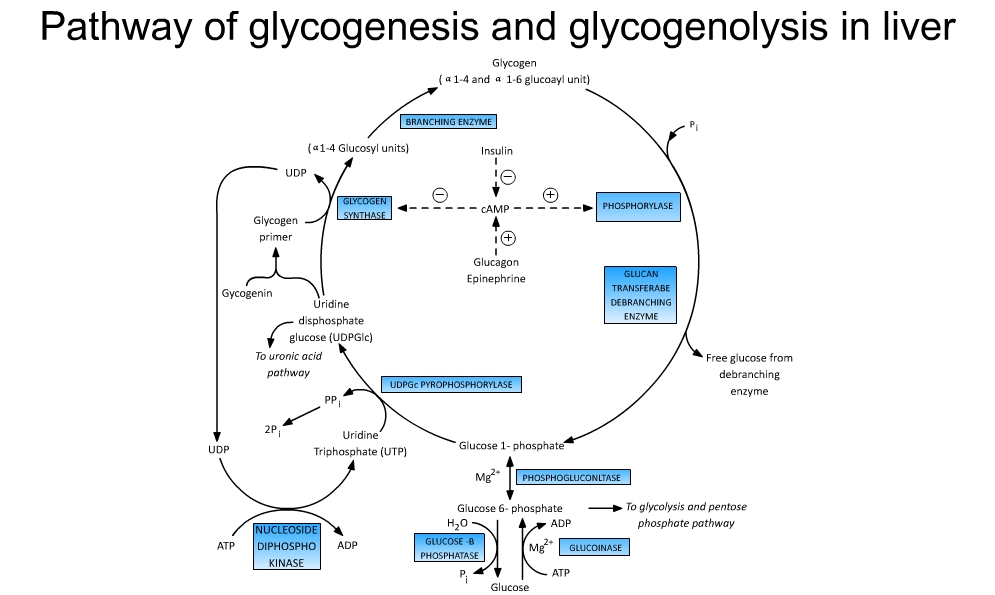Glycogen Metabolism: Glycogenolysis and MCQs For NEET, GPAT, CSIR NET, SSC, UPSC Exam
Glycogen is the major storage form of glucose mainly in the muscle and liver. Also most of the cells store minute amounts of glycogen. Glycogen is composed of glycosyl units which are linked by alpha-1,4 glycosidic bonds.
The concentration of liver glycogen is greater than in muscle tissues; because muscle tissue comprises of large amount of mass, so its storage capacity is three to four times that of liver.
The formation and utilization of of glycogen in the body with the help of enzymatic system is called glycogen metabolism.
In this article we are going to study about 2nd part of glycogen metabolism which is known as glycogenolysis.
Glycogenolysis
Glycogenolysis is the degradation of glycogen to glucose-6-phosphate in muscle and glucose in liver. Glycogenolysis is not the reverse of glycogenesis but it is the separate pathway.
Glycogenolysis occurs in the cytosol of muscle and liver cells
Pathway for Glycogenolysis
The pathway for both glycogenesis and glycogenolysis is described in the below picture

Reactions of glycogenolysis
1. It occurs via the breakage of 1,4-linkage by utilizing the phosphate group so that’s why it is called phosphorolytic cleavage.
2. Phosphorysis continue up to it reaches the branching point; where the other enzyme called debranching enzyme comes into action. Debranching enzyme has two functions
- Glucan transfer: i transfer the 3-4 unit to other branch
- 1,6- glycosidase- breaks the 1,6- linkage.
3. The combine action of both glycogen phosphorylase and debranching enzyme results in complete breakdown of glycogen into glucose-1-phosphate and free glucose.
4. Glucose1-1-phosphate is converted to glucose-6- phosphate by phosphoglucomutase enzyme. It is a reversible reaction and is utilized in both glycogenesis and glycogenolysis.
5. Only in liver, glucose-6-phosphate is converted to glucose because the glucose-6-phosphatase enzyme is found in liver. The glucose is then transferred from hepatic cell to the blood tp maintain the blood glucose level in humans.
Regulation of Glycogenolysis
The principal enzyme which controls the glycogenolysis is glycogen phosphorylase. The control of this enzyme in muscle and liver differs. In muscle, the role of glycogen is to provide glucose-6-phosphate in response to the ATP for the muscle contractions. Whereas in liver, glycogen provides free glucose for maintaining the blood glucose level.
1. Phosphorylase enzyme enzyme is stimulated by cAMP. cAMP is in turn stimulated by epinephrine in liver and muscle and glucagon in liver. Whereas cAMP is inhibited by high concentration of insulin which in turn inhibits the glycogenolysis
2. Also the glycogen phosphorylase enzyme is inhibited by the high concentration of glucose-6-phosphate and ATP present in muscle.
3. Phosphorylase enzyme is also stimulated by high concentration of Ca ions and AMP.
Significance of glycogenolysis
1. In liver, in between the meals, the blood glucose level are maintained within the normal range by release of glucose.
2. In muscle, glycogen must be readily available all the time as the source of glucose for muscle contraction.
Multiple choice questions(MCQs)
1. Why do glycogen metabolism takes place?
A. carbohydrate metabolism B. fat metabolism
C. lipid metabolism D. amino acid metabolism
2. Which enzyme is considered as the principal enzyme for the regulation of glycogenolysis?
A. phosphoglucomutase B. glycogen phosphorylase
C. glucose-6-phosphatase D. glucan transferase
3. Where glycogenolysis takes place?
A. cytosol B. mitochondria
C. ribosomes D. endoplasmic reticulum
4. Which of the following statement is NOT true?
A. glycogen metabolism is divided in 4 parts
B. glycogenolysis is degradation of glycogen
C. glycogen metabolism occurs in muscle and liver
D. the concentration of liver glycogen is greater than muscle tissue
5. What is the main function of debranching enzyme?
A. forms free glucose B. forms ATP molecules
C. transfers the glycosidic units D. both A and C
6. Which enzyme catalyzes the reaction which is utilized In both glycogenesis and glycogenolysis?
A. phosphoglucomutase B. glycogen phosphorylase
C. glucose-6-phosphatase D. glucan transferase
7. Match the following-
a. epinephrine 1. Stimulates cAMP
b. insulin 2. Inhibits glycogen phosphorylase
c. glucose-6-phosphate 3. Inhibits cAMP
d. Ca ions 4. Stimulates glycogen phosphorylase
8. What is the need of glycogenolysis in muscle?
A. for muscle relaxation B. muscle contraction
C. maintain blood glucose level D. all of the above
9. Which enzyme catalyzes the only reversible reaction of whole glycogen metabolism
A. phosphoglucomutase B. glycogen phosphorylase
C. glucose-6-phosphatase D. glucan transferase
10. Why muscle cannot release glucose into blood and is used exclusively by itself?
A. muscles cannot do extra work B. all glucose is used for muscle contraction
C. absence of glucose-6-phosphatase D. both A and B
11. Which of the following inhibits the glycogenolysis?
A. epinephrine B. glucagon
C. Ca ions D. none of the above
12. Which form of energy inhibits the glycogenolysis?
A. FAD B. AMP
C. ATP D. NADH
13. Which type of bond links the glycosyl units of glycogen compounds?
A. hydrogen bonds B. covalent bonds
C. glycosidic bonds D. sometimes A and sometimes C
14. Which enzyme catalyzes the reaction of glycogenolysis?
A. phosphoglucomutase B. glycogen phosphorylase
C. glucose-6-phosphatase D. all of the above
15. Where is glucose-6-phosphate mainly used?
A. glycolysis B. TCA cycle
C. HMP shunt D. both A and C
ANSWERS:-
- carbohydrate metabolism
- glycogen phosphorylase
- cytosol
- glycogen metabolism is divided in four parts
- both A and C
- phosphoglucomutase
- a – 1 b – 3 c – 2 d – 4
- muscle contraction
- phosphoglucomutase
- absence of glucose-6-phosphatase
- none of the above
- ATP
- glycosidic bonds
- all of the above
- both A and C
Participate in Online FREE GPAT TEST: CLICK HERE
Participate in Online FREE Pharmacist TEST: CLICK HERE
Participate in Online FREE Drug Inspector TEST: CLICK HERE
Participate in CSIR NET JRF Mock Test
REFERENCE:- Pankaja Naik- Biochemistry; 4th edition; page no:- 183-187.